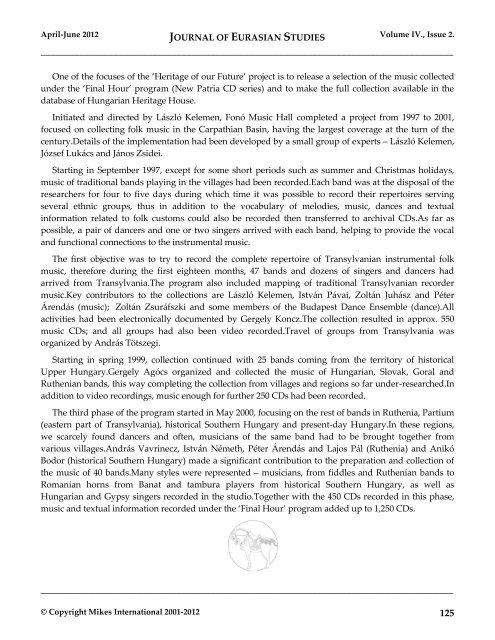Create successful ePaper yourself
Turn your PDF publications into a flip-book with our unique Google optimized e-Paper software.
April-June 2012 JOURNAL OF EURASIAN STUDIES Volume IV., Issue 2.<br />
_____________________________________________________________________________________<br />
One <strong>of</strong> the focuses <strong>of</strong> the ‘Heritage <strong>of</strong> our Future’ project is to release a selection <strong>of</strong> the music collected<br />
under the ‘Final Hour’ program (New Patria CD series) and to make the full collection available in the<br />
database <strong>of</strong> Hungarian Heritage House.<br />
Initiated and directed by László Kelemen, Fonó Music Hall completed a project from 1997 to 2001,<br />
focused on collecting folk music in the Carpathian Basin, having the largest coverage at the turn <strong>of</strong> the<br />
century.Details <strong>of</strong> the implementation had been developed by a small group <strong>of</strong> experts – László Kelemen,<br />
József Lukács and János Zsidei.<br />
Starting in September 1997, except for some short periods such as summer and Christmas holidays,<br />
music <strong>of</strong> traditional bands playing in the villages had been recorded.Each band was at the disposal <strong>of</strong> the<br />
researchers for four to five days during which time it was possible to record their repertoires serving<br />
several ethnic groups, thus in addition to the vocabulary <strong>of</strong> melodies, music, dances and textual<br />
information related to folk customs could also be recorded then transferred to archival CDs.As far as<br />
possible, a pair <strong>of</strong> dancers and one or two singers arrived with each band, helping to provide the vocal<br />
and functional connections to the instrumental music.<br />
The first objective was to try to record the complete repertoire <strong>of</strong> Transylvanian instrumental folk<br />
music, therefore during the first eighteen months, 47 bands and dozens <strong>of</strong> singers and dancers had<br />
arrived from Transylvania.The program also included mapping <strong>of</strong> traditional Transylvanian recorder<br />
music.Key contributors to the collections are László Kelemen, István Pávai, Zoltán Juhász and Péter<br />
Árendás (music); Zoltán Zsuráfszki and some members <strong>of</strong> the Budapest Dance Ensemble (dance).All<br />
activities had been electronically documented by Gergely Koncz.The collection resulted in approx. 550<br />
music CDs; and all groups had also been video recorded.Travel <strong>of</strong> groups from Transylvania was<br />
organized by András Tötszegi.<br />
Starting in spring 1999, collection continued with 25 bands coming from the territory <strong>of</strong> historical<br />
Upper Hungary.Gergely Agócs organized and collected the music <strong>of</strong> Hungarian, Slovak, Goral and<br />
Ruthenian bands, this way completing the collection from villages and regions so far under-researched.In<br />
addition to video recordings, music enough for further 250 CDs had been recorded.<br />
The third phase <strong>of</strong> the program started in May 2000, focusing on the rest <strong>of</strong> bands in Ruthenia, Partium<br />
(eastern part <strong>of</strong> Transylvania), historical Southern Hungary and present-day Hungary.In these regions,<br />
we scarcely found dancers and <strong>of</strong>ten, musicians <strong>of</strong> the same band had to be brought together from<br />
various villages.András Vavrinecz, István Németh, Péter Árendás and Lajos Pál (Ruthenia) and Anikó<br />
Bodor (historical Southern Hungary) made a significant contribution to the preparation and collection <strong>of</strong><br />
the music <strong>of</strong> 40 bands.Many styles were represented – musicians, from fiddles and Ruthenian bands to<br />
Romanian horns from Banat and tambura players from historical Southern Hungary, as well as<br />
Hungarian and Gypsy singers recorded in the studio.Together with the 450 CDs recorded in this phase,<br />
music and textual information recorded under the ‘Final Hour’ program added up to 1,250 CDs.<br />
_____________________________________________________________________________________<br />
© Copyright Mikes International 2001-2012 125
















